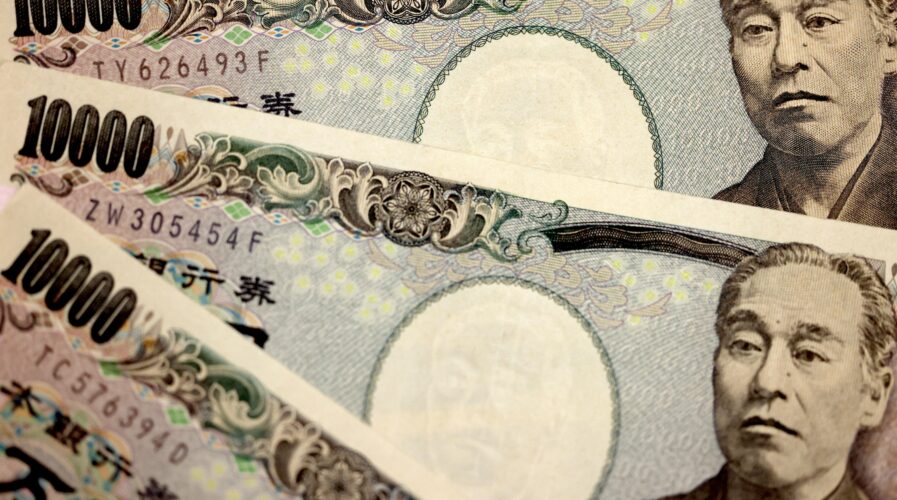
CBDC: Bank of Japan is in no rush to issue digital yen. Here’s their plan instead. (Photo by Behrouz MEHRI / AFP)
CBDC: Bank of Japan is in no rush to issue digital yen
- BoJ said it won’t issue digital yen with the aim of achieving negative interest rates.
- The bank is moving towards phase two of its proof of concept by testing the technical feasibility.
- With or without CBDC, BoJ wants to avoid a system that is too unique to be used beyond Japan.
Around the globe, countries have been exploring the benefits and drawbacks of central bank digital currencies (CBDCs). Major central banks have even been publishing a multitude of in-depth assessments of related policy issues in regards to CBDCs. Japan, after launching the first phase of its proof of concert (PoC) in April 2021, has moved towards phase two this month, but is still in no rush to issue digital yen–despite the global hype.
BoJ Executive Director Shinichi Uchida in his speech during the third meeting of the Liaison and Coordination Committee on CBDC yesterday shared that “as planned, the BoJ has finished the PoC Phase 1, which aims to test the technical feasibility of the core functions and features required for CBDC, and has moved on to PoC Phase 2 this April.”
Only upon the completion of its PoC, if the bank finds it necessary to move further forward, will they consider a pilot program that involves financial institutions and payment service providers, Uchida said. “In the PoC Phase 2, the bank plans to implement more complex, additional functions of CBDC to the core functions explored in Phase 1 and investigate their technical feasibility and challenges,” he added.
The country’s central bank has in fact emphasized a few times that it has no definite plans to issue a CBDC anytime soon but if BoJ were to do so, Uchida said the digital currency would need to co-exist with private-sector payment services. However, at this point, from the perspective of the payment and settlement systems as a whole, Uchida said they cannot ignore the possibility that such individual business behaviors could exacerbate the issues of market fragmentation and market dominance.
“To prevent these issues from materializing and to make payment and settlement systems safe and seamless, we need to consider ways to provide the “unprofitable” part in private payment services. The reason behind such unprofitability is that those payment service providers could bear the cost of ensuring overall safety and interoperability. Therefore, one policy option is that the entire financial sector or the wider society collectively provides the “unprofitable” part as a non-competitive area,” he added.
The Bank of Japan has two basic ideas for digital yen, if issued
Uchida recalled in the speech the two basic ideas Japan needs to consider. First, central banks should acknowledge the role of CBDC as a public good and ensure coexistence with private sector payment services. Second, “vertical coexistence,” meaning how various entities share roles within a CBDC ecosystem, would become important, in addition to “horizontal coexistence.”
As potential designs for an ecosystem, he assumed a structure where the central bank issues a CBDC as a public good, and private businesses allow end-users to use CBDC with their own overlay services. “We could also assume a structure where CBDC is circulated through various infrastructures or platforms developed by private businesses. Such an ecosystem would allow private businesses to avoid overlapping investment in the noncompetitive field, and foster an environment where they can innovate and compete while ensuring interoperability,” he noted.
Another crucial point in exploring potential designs for a CBDC according to Uchida is that the CBDC’s core system the central bank develops should be highly reliable. “Since a CBDC would be used by the whole general public, the CBDC system is more likely to be the target of cyberattacks, compared to digital payment services provided by private entities. In addition, we need to be well aware that the social impact would be greater if the CBDC system suspends service,” he highlighted.
Reiterating the fact that the bank has currently no plan to issue CBDC, Uchida believes that the decision as to whether or not a CBDC should be issued cannot be made by the bank nor by the financial sector alone. “It will have to be judged by the Japanese people. In doing so, we must consider two issues as mentioned earlier: first, what sort of CBDC would be appropriate as a public good to be provided by the central bank; and second, how to build a highly reliable CBDC ecosystem.”
What happens in phase two PoC?
In PoC Phase 2, the bank plans to explore features to set a limit on the amount of transactions and/or holdings of CBDC as safeguards against an unpredictable shift of deposits away from banks. The Bank will also consider remuneration functionality, the executive director said, adding that remuneration on CBDC might not be necessary.
“While the idea of using such a functionality as a means to achieve a negative interest rate is sometimes discussed in academia, the bank will not introduce CBDC on this ground. It is unlikely that such a motivation would be supported by the general public. Furthermore, such a remuneration functionality would be operationally unrealistic while cash still exists,” he stated.
The BoJ is also seeking more opportunities to ask for public opinion this fiscal year, presenting more specific system design options for a CBDC if it were to be issued. Most importantly to Uchida, with or without CBDC, he believes that Japan should avoid a system that is too unique to be used beyond the country.
“Any system that does not fit with global standards would be placed at a disadvantage in the digital world, no matter how well it is tailored for domestic needs. While placing a great emphasis on collaboration among major central banks, the bank aims to closely follow global trends and contribute to shaping them,” he concluded.
READ MORE
- Ethical AI: The renewed importance of safeguarding data and customer privacy in Generative AI applications
- How Japan balances AI-driven opportunities with cybersecurity needs
- Deploying SASE: Benchmarking your approach
- Insurance everywhere all at once: the digital transformation of the APAC insurance industry
- Google parent Alphabet eyes HubSpot: A potential acquisition shaping the future of CRM


